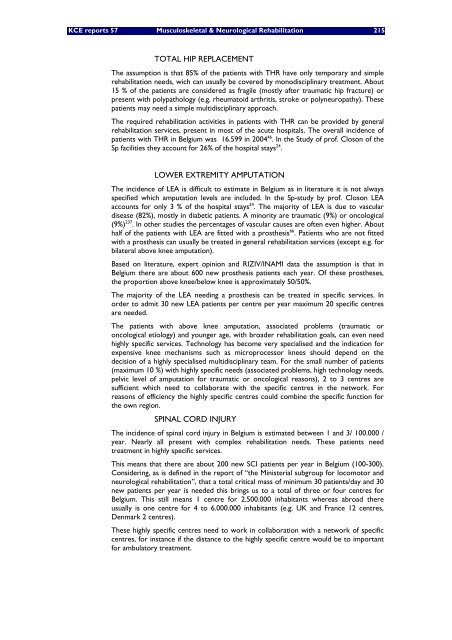The report is available in English with a French summary - KCE
The report is available in English with a French summary - KCE
The report is available in English with a French summary - KCE
You also want an ePaper? Increase the reach of your titles
YUMPU automatically turns print PDFs into web optimized ePapers that Google loves.
<strong>KCE</strong> <strong>report</strong>s 57 Musculoskeletal & Neurological Rehabilitation 215<br />
TOTAL HIP REPLACEMENT<br />
<strong>The</strong> assumption <strong>is</strong> that 85% of the patients <strong>with</strong> THR have only temporary and simple<br />
rehabilitation needs, wich can usually be covered by monod<strong>is</strong>cipl<strong>in</strong>ary treatment. About<br />
15 % of the patients are considered as fragile (mostly after traumatic hip fracture) or<br />
present <strong>with</strong> polypathology (e.g. rheumatoid arthrit<strong>is</strong>, stroke or polyneuropathy). <strong>The</strong>se<br />
patients may need a simple multid<strong>is</strong>cipl<strong>in</strong>ary approach.<br />
<strong>The</strong> required rehabilitation activities <strong>in</strong> patients <strong>with</strong> THR can be provided by general<br />
rehabilitation services, present <strong>in</strong> most of the acute hospitals. <strong>The</strong> overall <strong>in</strong>cidence of<br />
patients <strong>with</strong> THR <strong>in</strong> Belgium was 16.599 <strong>in</strong> 2004 46 . In the Study of prof. Closon of the<br />
Sp facilities they account for 26% of the hospital stays 24 .<br />
LOWER EXTREMITY AMPUTATION<br />
<strong>The</strong> <strong>in</strong>cidence of LEA <strong>is</strong> difficult to estimate <strong>in</strong> Belgium as <strong>in</strong> literature it <strong>is</strong> not always<br />
specified which amputation levels are <strong>in</strong>cluded. In the Sp-study by prof. Closon LEA<br />
accounts for only 3 % of the hospital stays 24 . <strong>The</strong> majority of LEA <strong>is</strong> due to vascular<br />
d<strong>is</strong>ease (82%), mostly <strong>in</strong> diabetic patients. A m<strong>in</strong>ority are traumatic (9%) or oncological<br />
(9%) 237 . In other studies the percentages of vascular causes are often even higher. About<br />
half of the patients <strong>with</strong> LEA are fitted <strong>with</strong> a prosthes<strong>is</strong> 66 . Patients who are not fitted<br />
<strong>with</strong> a prosthes<strong>is</strong> can usually be treated <strong>in</strong> general rehabilitation services (except e.g. for<br />
bilateral above knee amputation).<br />
Based on literature, expert op<strong>in</strong>ion and RIZIV/INAMI data the assumption <strong>is</strong> that <strong>in</strong><br />
Belgium there are about 600 new prosthes<strong>is</strong> patients each year. Of these prostheses,<br />
the proportion above knee/below knee <strong>is</strong> approximately 50/50%.<br />
<strong>The</strong> majority of the LEA need<strong>in</strong>g a prosthes<strong>is</strong> can be treated <strong>in</strong> specific services. In<br />
order to admit 30 new LEA patients per centre per year maximum 20 specific centres<br />
are needed.<br />
<strong>The</strong> patients <strong>with</strong> above knee amputation, associated problems (traumatic or<br />
oncological etiology) and younger age, <strong>with</strong> broader rehabilitation goals, can even need<br />
highly specific services. Technology has become very special<strong>is</strong>ed and the <strong>in</strong>dication for<br />
expensive knee mechan<strong>is</strong>ms such as microprocessor knees should depend on the<br />
dec<strong>is</strong>ion of a highly special<strong>is</strong>ed multid<strong>is</strong>cipl<strong>in</strong>ary team. For the small number of patients<br />
(maximum 10 %) <strong>with</strong> highly specific needs (associated problems, high technology needs,<br />
pelvic level of amputation for traumatic or oncological reasons), 2 to 3 centres are<br />
sufficient which need to collaborate <strong>with</strong> the specific centres <strong>in</strong> the network. For<br />
reasons of efficiency the highly specific centres could comb<strong>in</strong>e the specific function for<br />
the own region.<br />
SPINAL CORD INJURY<br />
<strong>The</strong> <strong>in</strong>cidence of sp<strong>in</strong>al cord <strong>in</strong>jury <strong>in</strong> Belgium <strong>is</strong> estimated between 1 and 3/ 100.000 /<br />
year. Nearly all present <strong>with</strong> complex rehabilitation needs. <strong>The</strong>se patients need<br />
treatment <strong>in</strong> highly specific services.<br />
Th<strong>is</strong> means that there are about 200 new SCI patients per year <strong>in</strong> Belgium (100-300).<br />
Consider<strong>in</strong>g, as <strong>is</strong> def<strong>in</strong>ed <strong>in</strong> the <strong>report</strong> of “the M<strong>in</strong><strong>is</strong>terial subgroup for locomotor and<br />
neurological rehabilitation”, that a total critical mass of m<strong>in</strong>imum 30 patients/day and 30<br />
new patients per year <strong>is</strong> needed th<strong>is</strong> br<strong>in</strong>gs us to a total of three or four centres for<br />
Belgium. Th<strong>is</strong> still means 1 centre for 2.500.000 <strong>in</strong>habitants whereas abroad there<br />
usually <strong>is</strong> one centre for 4 to 6.000.000 <strong>in</strong>habitants (e.g. UK and France 12 centres,<br />
Denmark 2 centres).<br />
<strong>The</strong>se highly specific centres need to work <strong>in</strong> collaboration <strong>with</strong> a network of specific<br />
centres, for <strong>in</strong>stance if the d<strong>is</strong>tance to the highly specific centre would be to important<br />
for ambulatory treatment.

















